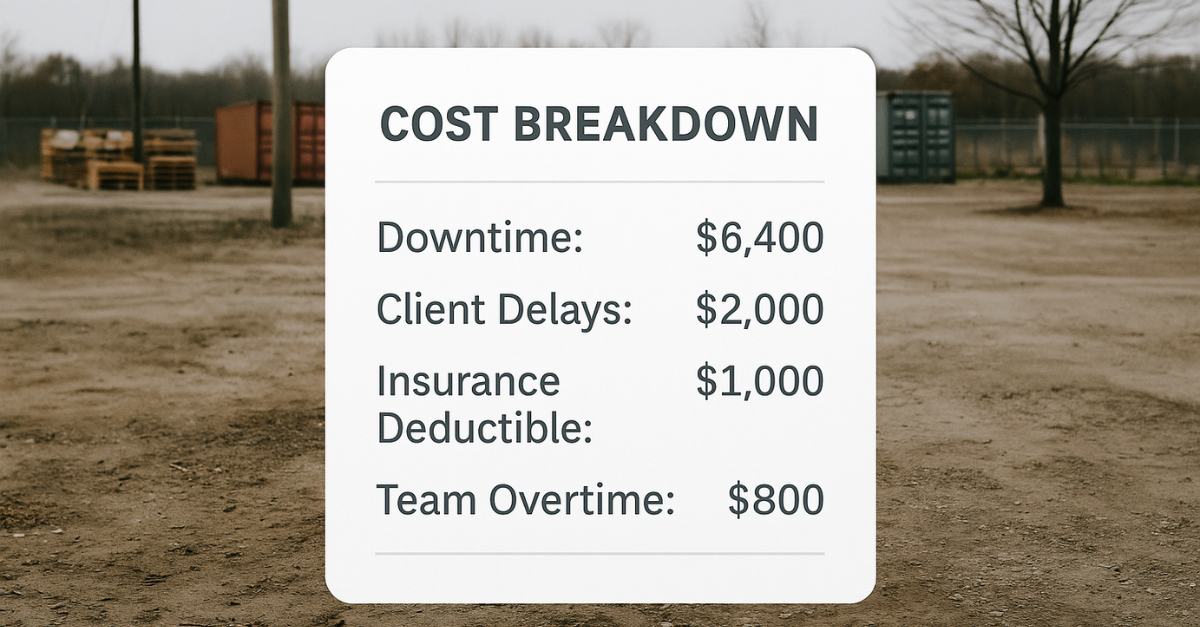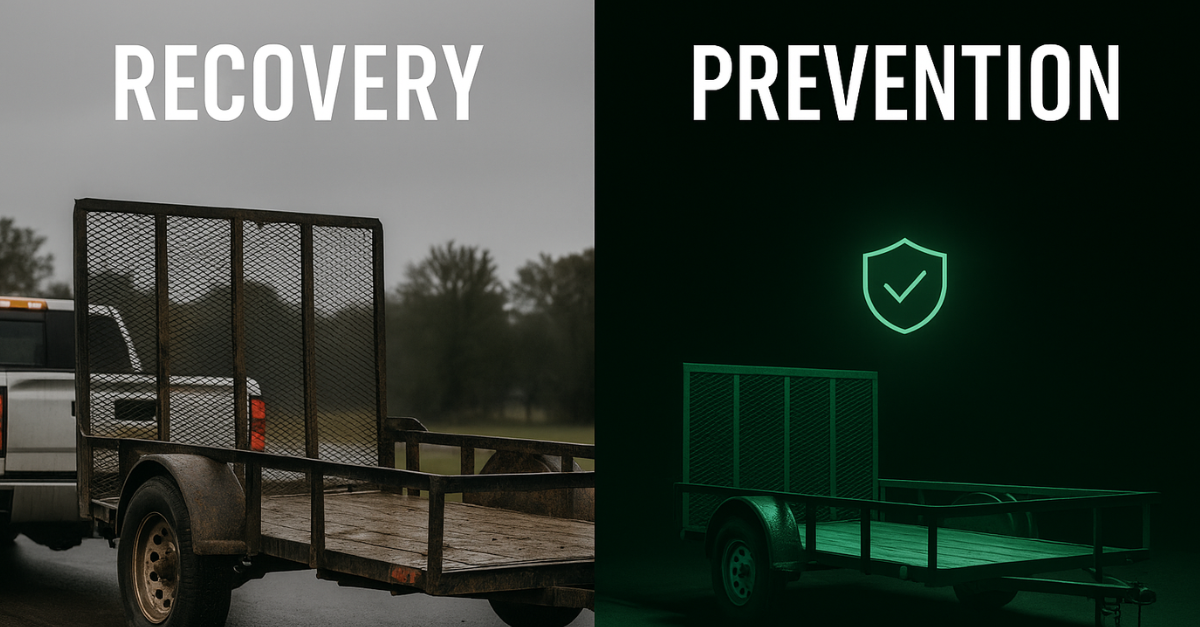Every time a company posts about recovering a stolen trailer, vending machine, or generator, it feels like a win. Leadership breathes a sigh of relief. Teams feel reassured. Social media celebrates the outcome. But in reality, the damage has already been done.
In the world of physical assets, recovery is not success. It is a reaction. It is proof that something went wrong. And more often than not, it is too little, too late.
If you’re investing in GPS asset tracking only to recover what was stolen, you’re missing the bigger picture. Recovery is not the real return on investment. Prevention is.
This is why GPS asset tracking for theft prevention must be positioned as a frontline business strategy, not just a reactive measure.
The High Price of a False Win
Let’s walk through a common scenario. A contractor discovers on Monday morning that a job site trailer is missing. It contained tools, safety equipment, and critical parts. Calls are made. Police reports are filed. A tracking alert is finally activated, and two days later, the trailer is recovered across state lines.
Everyone breathes easier. But what did this recovery actually cost?
- Crews lost two days of productivity.
- A high-value client experienced delays.
- Replacement tools had to be sourced to keep other jobs moving.
- Internal staff hours were spent on reporting, calls, and logistics.
- The insurer was notified, which may increase future premiums.
Even though the asset came back, the damage was already in motion. The total operational cost may have exceeded the value of the asset itself. Worse, the company accepted this as success because they got it back.
GPS asset tracking for theft prevention shifts this mindset. It asks a better question. What if the asset never left the job site in the first place?

The Critical Time Gap That Exposes Your Business
In most theft scenarios, the biggest vulnerability is not the theft itself. It is the delay between when the asset disappears and when someone notices it is gone. That gap can stretch for hours or even days.
During that time, assets can cross state lines, be disassembled for parts, or be hidden in a warehouse. In some cases, they are sold or destroyed before any recovery efforts begin. This lag period is where businesses lose control.
Why does this happen?
- Lack of movement alerts for non-powered assets
- No geofencing to detect unauthorized travel
- Inactive tracking systems outside work hours
- No behavior-based alerts like door opening or vibration
The most dangerous thing a business can do is assume that daily visibility checks or manual audits are enough. In today’s environment, where theft is increasingly organized and targeted, relying on human detection is no longer safe.
GPS asset tracking for theft prevention eliminates this delay by turning every movement into a monitored event. Businesses are notified the moment something deviates from expected behavior, not hours after the loss occurs.
Beyond Location: Turning GPS into Business Intelligence
Many companies still believe that GPS tracking is about knowing where something is. While location is essential, it is only a small part of the equation.
Modern GPS asset tracking systems provide actionable insights that drive operational efficiency, risk management, and theft prevention. Here’s how:
- Geofencing triggers alerts when an asset enters or exits a predefined area.
- Motion sensors detect movement during unauthorized hours.
- Tamper alerts notify teams if a device is disturbed or compromised.
- Tilt and vibration sensors catch suspicious handling or loading behavior.
- Door sensors track unauthorized access to trailers, kiosks, and containers.
These features transform a GPS tracker from a location pin into an always-on sentinel. Businesses move from passive observation to active monitoring.
This is the difference between GPS as a tracking device and GPS as a prevention strategy.
Recovery as a Cultural Problem
The narrative around recovery is deeply embedded in company culture. Teams are trained to spring into action once something is stolen. Executives applaud the process. Insurance companies reimburse part of the cost. It feels like the system worked.
But that is a dangerous illusion.
If the system only activates once theft is detected, the system is broken. It prioritizes damage control instead of damage prevention.
GPS asset tracking for theft prevention reframes the conversation. It encourages businesses to ask new questions:
- Why was this asset vulnerable in the first place?
- What behaviors went unmonitored?
- Could this event have been stopped before it escalated?
These questions create better systems, better awareness, and better outcomes. They replace post-theft paralysis with proactive protection.
The Real Return on Prevention
Some businesses hesitate to invest in asset tracking technology because they see it as an added expense. But the financial impact of even one incident can quickly exceed the entire cost of a full fleet deployment.
Consider the following:
- A single non-powered tracker often costs less than $150.
- Annual service plans are available for under $10 per month.
- The average recovery cost, including downtime, can range from $5,000 to $50,000 per incident.
- Legal fees, reputational damage, and client churn add invisible costs that cannot be recouped.
When comparing those numbers, the ROI becomes clear. Preventing even one incident pays for the tracking system many times over.
And that’s just the direct cost. The operational peace of mind, improved efficiency, and competitive advantage are worth even more.
GPS asset tracking for theft prevention is not just insurance. It is intelligence. It empowers businesses to move faster, respond smarter, and prevent loss before it begins.

The Competitive Advantage of Always Knowing
In competitive markets, visibility is no longer optional. Companies that can confidently say where their assets are, how they are being used, and whether they are safe, win more deals.
They demonstrate operational maturity to partners and insurers. They comply with regulatory requirements without scrambling. They fulfill client obligations with fewer disruptions.
This level of control becomes a differentiator. It turns GPS tracking from a backend tool into a forward-facing advantage.
Smart businesses use this to negotiate better insurance premiums, reduce fraud exposure, and win larger contracts with confidence.
Final Thoughts: Prevention is the Real Proof of Control
If your team is high-fiving after finding stolen equipment, it might be time to re-evaluate what success really looks like.
Recovery is not a strategy. It is an outcome of a failed system. Celebrating it creates complacency. It tells your team that loss is acceptable, as long as you get lucky enough to undo it.
But there is a better way.
GPS asset tracking for theft prevention eliminates the luck. It creates a system that works even when no one is watching. It prevents the story from ever being written.
Real success is not measured in what you recover. It is measured in what you never lose.
Stop rewarding recovery. Start preventing loss.
If you’re ready to replace reaction with prevention, let’s talk.
At HoloTrak, we work with businesses to transform tracking into proactive protection.
Schedule a quick consult today and see how prevention pays off.

